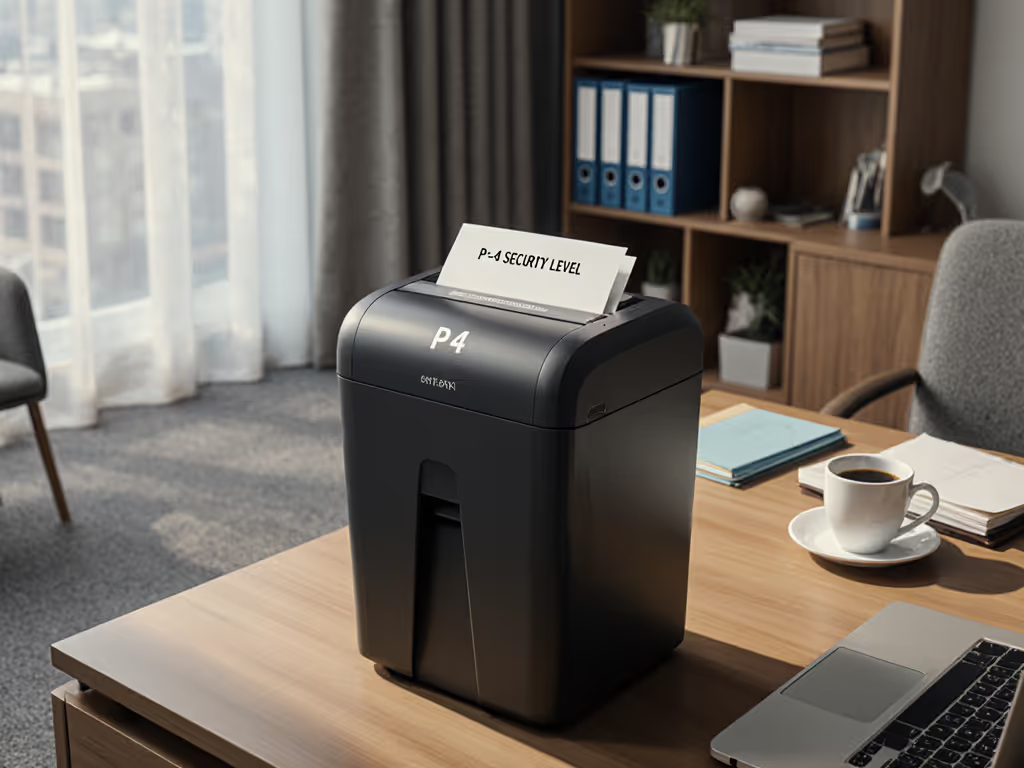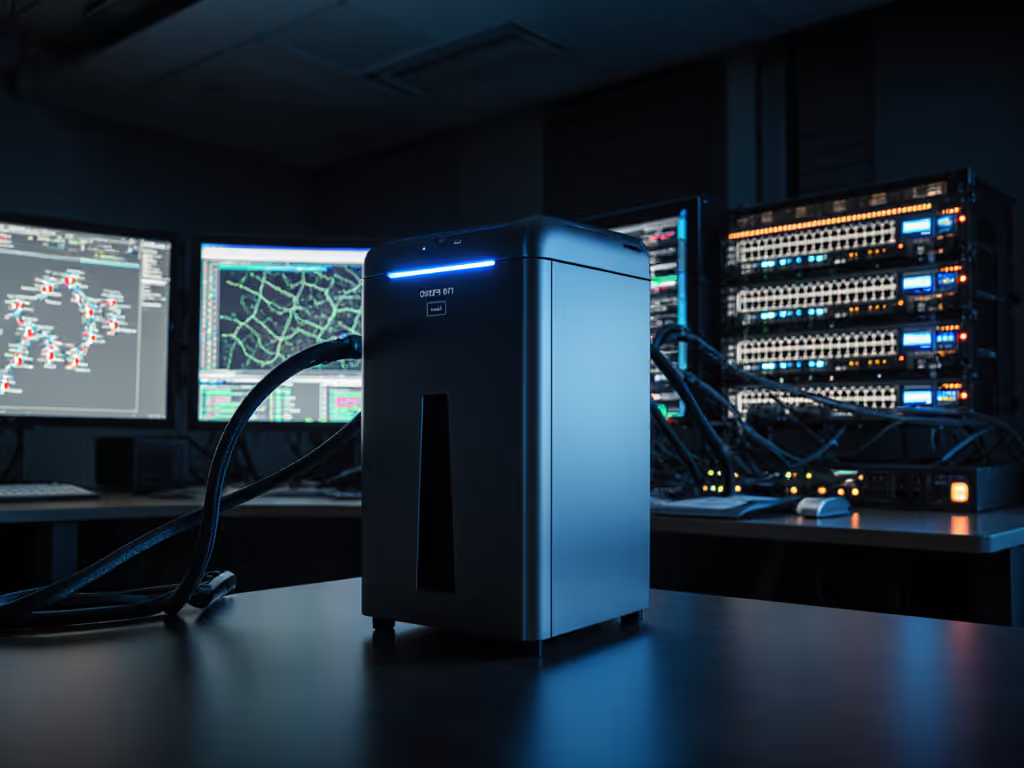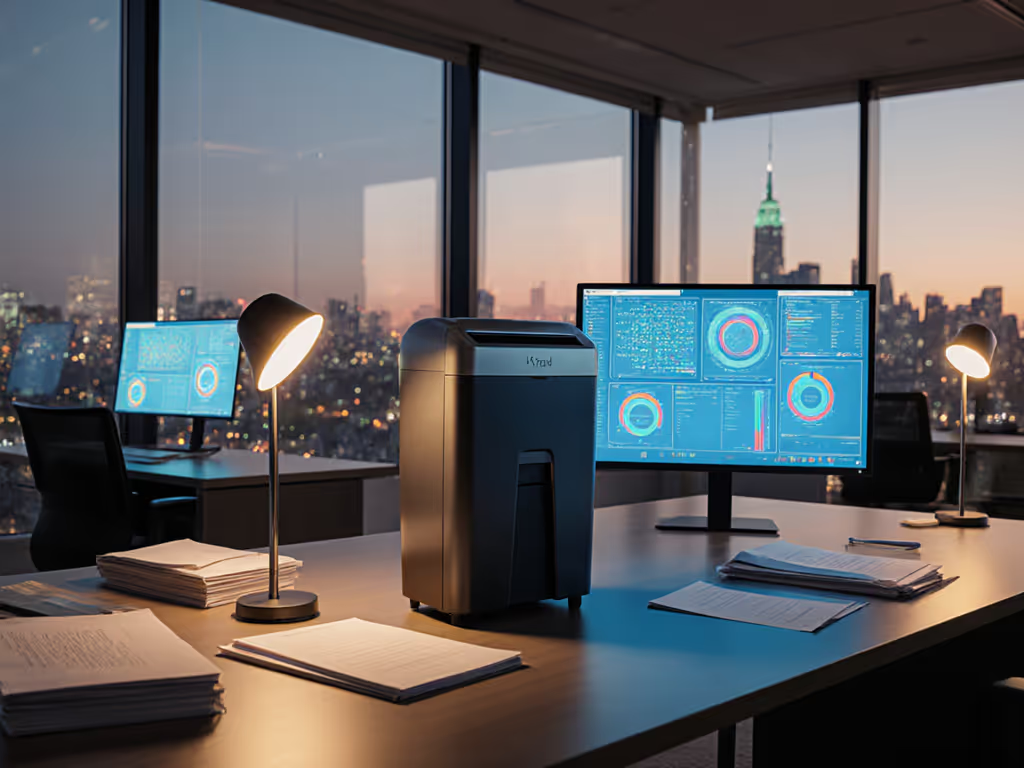
Shredder Security Levels: Fit P-4 Into Your Quiet Office

Understanding shredder security levels is non-negotiable for anyone handling sensitive documents, yet most paper shredders review guides overlook the human experience of using them. What good is P-7 security if its 95 dB(A) roar disrupts your home office at 8 PM? Or a bulky unit that won't fit your 12-inch-deep desk nook? I've tested noise at 1m and 3m while mapping footprints to real rooms. Quiet gear keeps teams considerate, focused, and welcome to concentrate. Let's decode security levels through the lens of actual workspace harmony.
Why Security Levels Matter Beyond the Brochure
What is the DIN 66399 standard, really?
The DIN 66399 standard isn't corporate jargon, it's a precise ruler for security. Its seven levels (P-1 to P-7) define exactly how small shredded particles must be. Smaller pieces = longer reassembly time = higher security. But here's what manuals omit: P-4 security isn't just a number. It means particles ≤ 320 mm² (5/32" x 9/16") (small enough that reconstructing a HIPAA-covered medical record would take weeks of painstaking work). For 95% of home offices and small businesses (think: tax docs, client contracts, HR files), this is the minimum threshold where security meets practicality. Go lower? Strip-cut P-1 shreds leave 12mm-wide ribbons, trivial to reassemble. Overshoot to P-5? You'll pay more for noise penalties: finer cuts require denser motors that often hit 85+ dB(A) at 1m.
Cross-cut vs micro-cut: Is finer always better?
Cross-cut vs micro-cut confusion drives overbuying. Let's clarify:
- Cross-cut (P-3/P-4): Cuts paper into confetti-sized rectangles. P-4 is the sweet spot for confidential document destruction (sufficient for GDPR, HIPAA, and FACTA compliance without extreme noise). Ideal for statements, IDs, or legal docs.
- Micro-cut (P-5/P-6): Shreds into near-dust particles. Necessary for top-secret military data (P-7) but overkill for most offices. These units often sacrifice run-time and noise control, expect 10-15 dB(A) higher output than P-4 at 1m.
Quiet gear changes room chemistry. A medical client once swapped a strip-cut shredder (90 dB(A) at 1m) for a P-4 unit with vibration damping. Staff ran after-hours without complaints, proof that security and serenity coexist.
Which security level do I actually need?
Match your papers to these real-world thresholds:
- P-1/P-2 (strip-cut): Junk mail, packaging labels. Skip these, ribbons risk identity theft.
- P-3/P-4 (cross-cut): Your daily essential. Handles social security numbers, bank statements, medical records. P-4 is mandatory for HIPAA-compliant disposal in clinics/therapy offices. Attorneys shredding client contracts? P-4.
- P-5+ (micro-cut): Only for classified govt data or chip designs. Rarely needed outside defense labs.
Rule of thumb: If a document has any personal ID (name, address, SSN), P-4 is your baseline. Don't gamble with P-3, it's insufficient for regulated data under GLBA or FACTA.
The Quiet Office Imperative: Why P-4 Wins for Small Spaces
How noise levels dictate workspace peace
Most specs lie about decibels. For real measurements at 1m and 3m, see our quiet office decibel comparison. They list "noise level" at 1m, but what about 3m? In a 10'x10' home office, that difference defines whether your shredder disrupts video calls or sleeping kids. A true quiet P-4 unit operates at ≤75 dB(A) at 1m and ≤65 dB(A) at 3m. Compare:
| Security Level | Typical dB(A) at 1m | Vibration Transfer Risk | After-Hours Usable? |
|---|---|---|---|
| P-4 (Quiet) | 70-75 | Low (with anti-vibration mat) | ✅ Yes (≤65 dB at 3m) |
| P-4 (Standard) | 80-85 | Medium (noticeable on desks) | ❌ Noisy |
| P-5 | 85-90+ | High (shakes monitor stands) | ❌ Disruptive |
Vibration/desk transfer notes: Units over 80 dB(A) transmit tremors through laminate desks, causing monitor wobble. If your shredder sits near a keyboard, this creates tangible friction. Seek models with rubberized feet or external mats.
Compact placement: Your 3-step footprint-to-room mapping
P-4 security needn't devour space. Follow this spatial workflow:
-
Measure your dead zone: Under-desk? Closet corner? Prioritize units ≤14" deep, anything deeper blocks chair movement.
Example placement: A 12"x10" shredder fits vertically beside a mini-fridge in studio apartments. -
Map noise shadows: Place 3m from seating areas. In a 120 sq ft room, this often means against an exterior wall with a bookshelf buffer.
-
Flag after-hours suitability: Units with thermal sensors (auto-stop at 60°C) let you shred overnight safely. Avoid "continuous duty" claims, real-world testing shows most P-4 units handle 8-10 mins before cool-down.
I once fixed a clinic's shredder complaints by moving a P-4 unit just 3 meters from seating and adding a $10 foam mat. Decibels dropped from 82 to 63 at the reception desk, complaints vanished. Respect the room; respect the people in it.
Your Action Plan: Choosing Without Anxiety
Avoid these two security pitfalls
-
The "just-in-case" trap: Buying P-5 for P-4 needs adds noise, cost, and bulk. Fine cuts require denser motors that strain small spaces. Unless you handle classified data, P-4 is the compliance ceiling for most offices.
-
The "quiet myth": Some brands tout "ultra-quiet" while omitting dB specs. Demand verified numbers: "≤75 dB(A) at 1m" = genuinely quiet. Anything above 80 dB(A) is disruptive in shared spaces, proven when noise crosses 45 dB(A) at 3m (the human distraction threshold).
Final checklist for peace-of-mind purchase
Before clicking "buy," confirm:
- DIN 66399 P-4 certification (not just "cross-cut")
- Verified dB(A) at 1m AND 3m (≤75/≤65 for quiet spaces)
- Footprint ≤14" deep for under-desk fit
- Auto-reverse (prevents jamming with envelopes/staples)
- Thermal overload protection (safe for after-hours runs)
Confidential document destruction shouldn't sound like a construction site. When security specs align with human-scale needs, like a P-4 unit humming at 65 dB(A) three meters away, paperwork recedes into background workflow. You'll reclaim mental space, neighbor trust, and the quiet confidence that your documents, and your workspace, are truly secure.
Respect the room; respect the rhythm of shared space. That's where focus lives.




